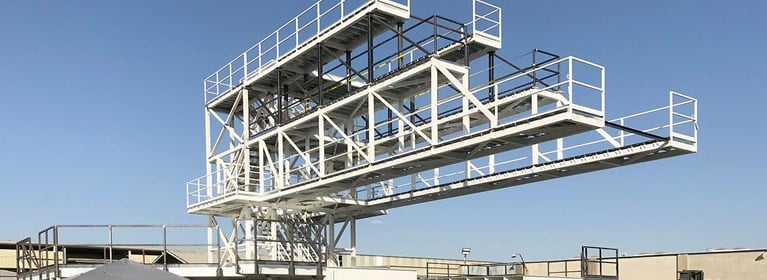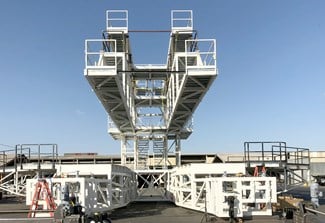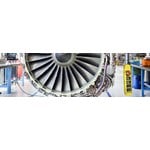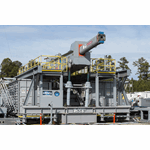Aircraft Maintenance System Fits All Using Turnkey Lifting System
Kern Steel
Aerospace |
Inspection & Maintenance |
By Jason Wills |
Dec 14, 2018
THE CHALLENGE
Kern Steel Fabrication, Inc. is a well-known structural steel fabricator located in Bakersfield, CA. One of their specialties is aircraft maintenance systems. Kern Steel was recently asked to develop an aircraft maintenance system that would accommodate various aircraft models. This system required a combination of walk ways, stairs and working platforms along with the ability to adjust the height of each platform in order to reach standard maintenance areas from cockpit to tail.
Adding to the complexity, adjusting the height of each level required accurate synchronization to keep platforms and heavy equipment level during the process. Not an easy task when in total the raise and lower of this large system could be more than 50 inches. Needless to say, safety of personnel and costly maintenance equipment during operation were key considerations in the design.
THE SOLUTION
Duff-Norton worked closely with Kern Steel to find the right solution for synchronous lifting and lowering of all platforms within the structure.
SYNCHRONIZATION
In order to achieve synchronous lifting, four mechanical actuators were employed, two mounted on the front and two on the back. To ensure level lift and lower of the platforms Duff-Norton developed a custom control system that could accurately synchronize the motion to within +/- 0.250 inches from actuator to actuator at a speed of approximately 6 inches/minute. Encoders and end of travel limit switches were included on each actuator to provide real-time positional feedback to the controls throughout the process.
SAFETY FEATURES
Duff-Norton provided a control system with a pendant to allow personnel to safely walk around the system while raising or lowering it. Encoder feedback from each actuator was used to synchronize the system. A human machine interface (HMI) was used to relay information about each actuator. To keep personnel safe two E-Stop buttons were integrated into the system. One on the pendant and one on the main control panel. The controls system also included two three color stack lights with an audible alarm. The stack lights would strobe to notify personnel the system was on, if the system was faulted, or that the system was in motion.
PREVENTATIVE MAINTENANCE
Duff-Norton’s system also included preventative maintenance indication. The system was designed to track motor contractor cycles for each actuator. When the system detected that any contractor was near life cycle the system warns the operator. The HMI relays information about faults, preventative maintenance, system motion, system synchronization, and physical inputs and outputs such as sensors and switches. Due to the outdoor location of the structure bellows boots were used on the top and bottom of the screw on each actuator to prevent damage by water or debris.
Related Articles
These systems improve safety, reduce repetitive motions, and increase productivity.
|
Aerospace |
Aug 1, 2019
From the muzzle-loading cannons of the USS Constitution to the Advanced Gun System on the U.S. Navy-built Zumwalt-class destroyers, naval warfare has always relied on explosives to fire projectiles at the enemy. A proof-of-concept railgun, elevated by two Duff-Norton Mechanical Actuators, can accelerate a projectile up to Mach 6 and fire it more than 100 nautical miles.
Power & Motion Technology |
Government |
Aug 31, 2017
Related Products
Load Capacity:
1/4 to 350 ton
North America - EN









